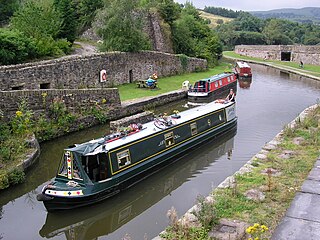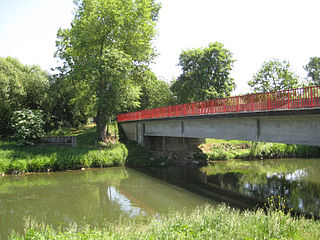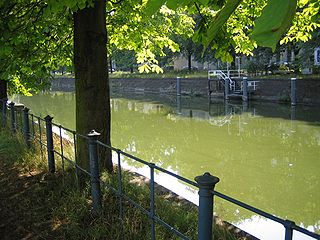Gallery
- The pleasure boat Kolibri goes Kamenka River, Suzdal, Vladimir Oblast
- Pleasure boat with passengers in traditional dress, Arashiyama, Kyoto (1909)
A pleasure craft (or pleasure boat) is a boat used for personal, family, and sometimes sports recreation. Such watercraft are divided into two main categories: motorboats and sailboats. There are also rowboats and canoes. They are used for holidays, for example on a river, lake, canal, waterway, in an archipelago or coastal area. Pleasure craft are normally kept at a marina. They may include accommodation for use while moored to the bank.
In Great Britain, many narrowboats were converted into pleasure craft from their previous use for cargo transport on canals, and today the same hull style is commonly used for new pleasure craft using the canal system.

A barge is a shoal-draft flat-bottomed boat, built mainly for river and canal transport of bulk goods. Originally barges were towed by draft horses on an adjacent towpath. Barges have changed throughout time. From 1967-1983 barges were considered a flat bottom boat that was nineteen feet in length or larger. Today, barges may be self-propelled, usually with a slow-revving diesel engine and a large-diameter fixed-pitch propeller. Otherwise, "dumb barges" must be towed by tugs, or pushed by pusher boats. Compared to a towed barge, a pusher system has improved handling and is more efficient, as the pushing tug becomes "part of the unit" and it contributes to the momentum of the whole.

Canals are waterways channels, or artificial waterways, for water conveyance, or to service water transport vehicles. They may also help with irrigation. It can be thought of as an artificial version of a river. Canals carry free surface flow under atmospheric pressure.

British Waterways, often shortened to BW, was a statutory corporation wholly owned by the government of the United Kingdom. It served as the navigation authority for the majority of canals and a number of rivers and docks in England, Scotland and Wales.

A narrowboat is a particular type of canal boat, built to fit the narrow locks of the United Kingdom. The UK's canal system provided a nationwide transport network during the Industrial Revolution, but with the advent of the railways, commercial canal traffic gradually diminished and the last regular long-distance traffic disappeared in 1970. However, some commercial traffic continued into the 1980s and beyond.
The Gloucester and Sharpness Canal is a canal in the west of England, between Gloucester and Sharpness; for much of its length it runs close to the tidal River Severn, but cuts off a significant loop in the river, at a once-dangerous bend near Arlingham. It was once the broadest and deepest canal in the world. The canal is 26.5 km long.

A waterway is any navigable body of water. Broad distinctions are useful to avoid ambiguity, and disambiguation will be of varying importance depending on the nuance of the equivalent word in other languages. A first distinction is necessary between maritime shipping routes and waterways used by inland water craft. Maritime shipping routes cross oceans and seas, and some lakes, where navigability is assumed, and no engineering is required, except to provide the draft for deep-sea shipping to approach seaports (channels), or to provide a short cut across an isthmus; this is the function of ship canals. Dredged channels in the sea are not usually described as waterways. There is an exception to this initial distinction, essentially for legal purposes, see under international waters.

The canal network of the United Kingdom played a vital role in the Industrial Revolution. The canals permitted the creation of wealth, by industry, that led to the British Empire in the Victorian Era. The UK was the first country to develop a nationwide canal network, which expanded to nearly 4,000 miles in length. The canals allowed raw materials to be transported to a place of manufacture, and finished goods to be transported to consumers, more quickly and cheaply than via a land based route.

The Rideau Canal, also known unofficially as the Rideau Waterway, connects Canada's capital city of Ottawa, Ontario, to Lake Ontario and the Saint Lawrence River at Kingston, Ontario. It is 202 kilometres long. The name Rideau, French for "curtain", is derived from the curtain-like appearance of the Rideau River's twin waterfalls where they join the Ottawa River. The canal system uses sections of two rivers, the Rideau and the Cataraqui, as well as several lakes. Parks Canada operates the Rideau Canal.

Regent's Canal is a canal across an area just north of central London, England. It provides a link from the Paddington Arm of the Grand Union Canal, 550 yards (500 m) north-west of Paddington Basin in the west, to the Limehouse Basin and the River Thames in east London. The canal is 8.6 miles (13.8 km) long.

A horse-drawn boat or tow-boat is a historic boat operating on a canal, pulled by a horse walking beside the canal on a towpath.

The Ill is a river in Alsace, in north-eastern France, and a left-bank, or western, tributary of the Rhine. It is 217 km (135 mi) long.

The canals of the United Kingdom are a major part of the network of inland waterways in the United Kingdom. They have a varied history, from use for irrigation and transport, through becoming the focus of the Industrial Revolution, to today's role of recreational boating. Despite a period of abandonment, today the canal system in the United Kingdom is again increasing in use, with abandoned and derelict canals being reopened, and the construction of some new routes. Canals in England and Wales are maintained by navigation authorities. The biggest navigation authorities are the Canal & River Trust and the Environment Agency, but other canals are managed by companies, local authorities or charitable trusts.

A houseboat is a boat that has been designed or modified to be used primarily as a home. Some houseboats are not motorized, because they are usually moored, kept stationary at a fixed point and often tethered to land to provide utilities. However, many are capable of operation under their own power. Float house is a Canadian and American term for a house on a float (raft); a rough house may be called a shanty boat. In Western countries, houseboats tend to be either owned privately or rented out to holiday-goers, and on some canals in Europe, people dwell in houseboats all year round. Examples of this include, but are not limited to, Amsterdam, London, and Paris.
The Pleasure Craft Operator Card (PCOC) is a document used in Canada as proof of competency to operate a recreational boat with a motor. It is required for any craft fitted with a motor, even if the motor is not in use, for example an auxiliary motor on a sailboat.

Lake Biwa Canal is a waterway in Japan constructed during the Meiji Period to transport water, freight, and passengers from Lake Biwa to the nearby City of Kyoto. The canal supplied Japan's first public hydroelectric power generator, which served from 1895 to provide electricity for Kyoto's trams.

The Landwehr Canal, or Landwehrkanal in German, is a 10.7-kilometre (6.6 mi) long canal parallel to the Spree river in Berlin, Germany, built between 1845 and 1850 according to plans by Peter Joseph Lenné. It connects the upper part of the Spree at the Osthafen in Friedrichshain with its lower part in Charlottenburg, flowing through Kreuzberg and Tiergarten.
Inland Electronic Navigational Charts (IENC) are electronic navigational charts for rivers, canals, lakes and other inland waters which are navigable. IENCs are displayed by an Inland Electronic Chart Display and Information System.

The Runcorn and Weston Canal was a short canal near Runcorn in Cheshire, England, constructed to link the Weston Canal, which is part of the River Weaver Navigation, to the Bridgewater Canal and Runcorn Docks. It was completed in 1859, but was little used. Around half of it became the Arnold Dock in 1876, when it was made wider and deeper, and linked to Fenton Dock by a ship lock. The dock section and some of the remaining canal were filled in during the 1960s, and the remainder is in a derelict state.

The Canal de l'Ourcq is a 108.1 km (67.2 mi) long canal in the Île-de-France region with 10 locks. It was built at a width of 3.20 m (10.5 ft) but was enlarged to 3.7 m (12 ft), which permitted use by more pleasure boats. The canal begins at Port-aux-Perches near the village of Troesnes, where it splits from the channeled River Ourcq, and flows to the Bassin de la Villette, where it joins the Canal Saint-Martin. Paris requires 380,000 cubic metres of water daily for cleaning the sewer system, gutters, and parks. The Canal de l'Ourcq provides about half of the requirement. Since 1983, the waterway has been designated for use by pleasure craft, and its water is designated for non-drinking uses.

The hotel barge came into being following the decline in commercial and freight carrying on the canals of Europe. Many working barges have been converted into floating hotels of varying degrees of luxury. This trend began in the 1960s and has now grown into a network of hotel barges operating on the canals and rivers of France, Belgium, the Netherlands, Germany and the UK. The majority of hotel barges operate on the French waterways, where the national authority Voies Navigables de France estimates their economic importance at 60 million euros of local income, or roughly 5% of all waterway tourism business in France.